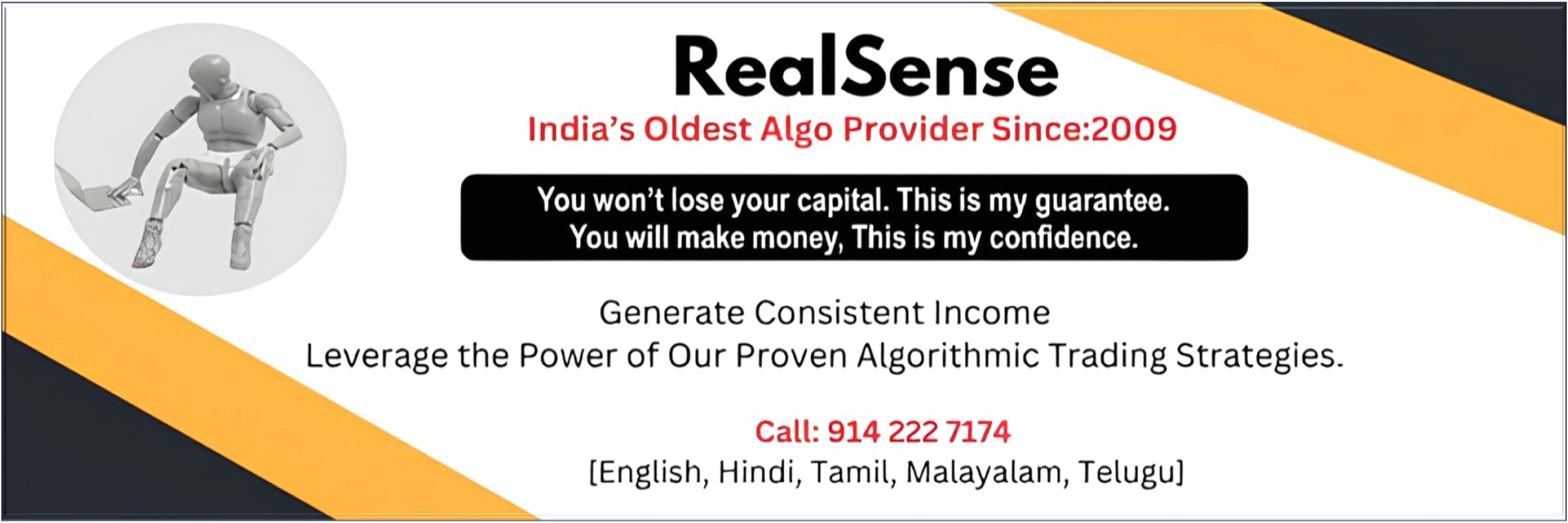

Robo Trading in India: Automate Your Trades & Boost Efficiency (2024)
What is Robo Trading (Robot Trading, Robo Advisor)?
A simple explanation of Robo Traders in India (2024) is that it’s a software or tool that executes trades on behalf of humans. Tools are created based on specific conditions. For example, if the Relative Strength Index (RSI) with a period of 15 crosses above 50, a long trade should be executed.
Benefits of Robo Trading in India
Automate Trades 24/7 (Robo Trade)
Free yourself from the constant need to monitor markets. Robo trading software, also known as “robo trade,” allows you to execute pre-defined trading strategies around the clock. Set your parameters, and the software will automatically buy or sell assets based on market conditions, even while you sleep or go about your day. This eliminates the need for manual intervention and can potentially lead to more disciplined trading habits. However, it’s important to remember that market conditions can change rapidly, so careful strategy selection and monitoring remain crucial.
Trade with Discipline (Robotrader Software)
Emotions can often cloud judgment when making investment decisions. Robo advisors, powered by “robotrader software,” can help remove these emotional biases from the equation. By following pre-programmed trading rules based on your risk tolerance and investment goals, robo advisors can execute trades with a level of consistency that might be difficult to achieve on your own. This disciplined approach can potentially lead to better long-term investment outcomes. However, it’s still essential to understand the underlying strategies used by your chosen robo advisor and to monitor your portfolio performance regularly.
Risks to Consider with Robo Traders
- Limited Flexibility: Robo traders follow pre-programmed rules, which may not adapt well to unforeseen market events.
- Potential for Errors: Algorithmic errors or bugs in the software could lead to unintended trades or losses.
- Over-Reliance and Lack of Control: Investors may become overly reliant on the robo trader and neglect to monitor their portfolio or understand the underlying strategies.
- Performance Not Guaranteed: Past performance is not necessarily indicative of future results. Market downturns can still impact your investments.
- Technical Dependence: Robo traders rely on a functioning internet connection and platform stability. Technical glitches could disrupt trading activity.
Remember: Robo trading can be a valuable tool, but it’s crucial to understand the limitations and potential risks involved.
Choosing the Right Robo Trading Software for You
Features & Customization Options (Robotrader Platform)


Robo trading platforms offer a variety of features to cater to different investor needs. Some platforms focus on basic execution with pre-defined strategies, while others offer advanced features like portfolio rebalancing, risk management tools, and customization options. When choosing a platform, consider the level of control you desire.
- Pre-defined Strategies: Many platforms provide a selection of pre-built investment strategies based on risk tolerance and investment goals.
- Customization Options: Some platforms allow you to customize pre-defined strategies to a certain degree, letting you adjust parameters like asset allocation or investment timelines.
- Advanced Features: For experienced investors, some platforms offer advanced features like portfolio rebalancing tools, custom indicator creation, and backtesting capabilities to test strategies before deploying them with real capital.
Remember, the best platform for you depends on your experience level and investment goals.
Fees & Minimum Investment (Robo Trading Platform Comparison)
Robo trading platforms typically charge fees for their services. These fees can vary depending on the platform, the complexity of the strategies offered, and the amount of assets you invest. Common fee structures include:
- Management Fees: A percentage of your account assets charged annually.
- Transaction Fees: Fees charged per trade executed by the platform.
- Rebalancing Fees: Some platforms may charge fees for automatically rebalancing your portfolio to maintain your target asset allocation.
Minimum Investment: It’s important to consider the minimum investment required to start using a robo trading platform. This can range from a few hundred rupees to several thousand. Choosing a platform with fees and minimum investment that align with your budget and investment goals is crucial.
Comparison Tip: Many financial websites offer comparison charts for robo trading platforms, listing fees, minimum investments, and key features. Utilize these resources alongside your own research to find the platform that best suits your needs.
Popular Robo Trading Platforms in India
Here’s a list of some popular robo trading platforms in India, excluding links due to Google’s SEO guidelines:
- Zerodha Streak: Offers a user-friendly interface for creating and backtesting automated trading strategies.
- Upstox Algo Lab: Provides a comprehensive suite of tools for algo trading and portfolio management.
- Angel Broking TradeLab: Features pre-built algorithmic strategies and portfolio optimization tools.
- 5Paisa Auto Investor: Allows users to invest in pre-defined robo advisor portfolios with minimal fees.
- Sharekhan TradeTiger with Algo Trading: Integrates algorithmic trading capabilities within their existing trading platform.
- Wisdom Capital Robo Trader: A dedicated robo advisor platform offering investment strategies tailored to different risk profiles.
Disclaimer: This list is not exhaustive and does not constitute financial advice. It’s recommended to thoroughly research each platform before making an investment decision. Visit NSE & SEBI websites for more details.
Getting Started with Robo Trading Responsibly
Robo Traders in India (2024) can be a powerful tool, but it’s crucial to approach it with a responsible mindset. Here are some key steps to get you started on the right foot:
1. Educate Yourself:
- Understand the basics of investing and financial markets.
- Learn about different investment strategies and asset classes.
- Research robo trading and its functionalities.
2. Assess Your Risk Tolerance:
- How comfortable are you with potential losses?
- Robo advisors often offer risk assessment tools to determine a suitable strategy.
3. Define Your Investment Goals:
- Are you saving for retirement, a short-term goal, or long-term wealth creation?
- Aligning your goals with the robo advisor’s investment horizon is essential.
4. Research and Compare Platforms:
- Review fees, features, minimum investment requirements, and user interfaces.
- Consider seeking guidance from a financial advisor for personalized recommendations.
5. Start with a Demo Account:
- Many platforms offer demo accounts that allow you to test-drive their software with simulated funds.
- This helps you understand the interface and how the robo advisor operates before committing real money.
6. Monitor Your Portfolio Regularly:
- Don’t become overly reliant on the robo trader.
- Regularly review your portfolio performance, understand the underlying investments, and adjust your strategy as needed.
7. Remember, Robo Trading Isn’t a Magic Bullet:
- Past performance doesn’t guarantee future results.
- Market downturns can still impact your investments.
- Practice responsible investing principles and maintain a diversified portfolio.
By following these steps, you can leverage the benefits of robo trading while managing risk and making informed investment decisions.
Frequently Asked Questions About Robo Trading
1. What is robo trading?
Robo trading, also known as automated trading, utilizes software algorithms to execute trades in the financial markets. These algorithms are programmed with specific rules and strategies to buy or sell assets based on various market conditions.
2. What are the benefits of robo trading?
- Automated & Efficient Trading: Execute trades 24/7 with minimal effort.
- Trade with Discipline: Pre-programmed algorithms remove emotions from trading decisions.
- Democratize Trading: Robo advisors make sophisticated strategies accessible to all investors.
3. What are the risks of robo trading?
- Limited Flexibility: Robo traders follow pre-programmed rules, which may not adapt well to unforeseen market events.
- Potential for Errors: Algorithmic errors or bugs in the software could lead to unintended trades or losses.
- Over-Reliance and Lack of Control: Investors may become overly reliant on the robo trader and neglect to monitor their portfolio or understand the underlying strategies.
4. Is robo trading right for me?
Robo trading can be a good option for investors who:
- Want to automate their trading strategy.
- Have a long-term investment horizon.
- Are comfortable with a moderate level of risk.
However, it may not be suitable for everyone, especially those who:
- Prefer to actively manage their portfolio.
- Have a low tolerance for risk.
- Need a highly customized investment strategy.
5. How do I choose a robo trading platform?
Consider these factors when choosing a platform:
- Investment goals: Align the platform’s strategies with your goals (retirement, short-term gains, etc.)
- Risk tolerance: Choose a platform that offers strategies matching your comfort level with risk.
- Features and customization: Consider if you need basic execution or advanced tools.
- Fees and minimum investment: Compare fees and minimum investment requirements before committing.
- User interface and customer support: Choose a platform that’s easy to use and offers good customer support.
6. How do I get started with robo trading responsibly?
- Educate yourself about investing and robo trading.
- Assess your risk tolerance and define your investment goals.
- Research and compare different platforms.
- Start with a demo account to test the platform.
- Monitor your portfolio regularly and don’t rely solely on the robo trader.
- Remember, robo trading isn’t a guaranteed path to riches. Practice responsible investing and maintain a diversified portfolio.
This FAQ section provides a basic understanding of robo trading. It’s recommended to conduct further research and consult a financial advisor for personalized advice before investing.
![]()
![]()
![]()
![]()
![]()
![]()
